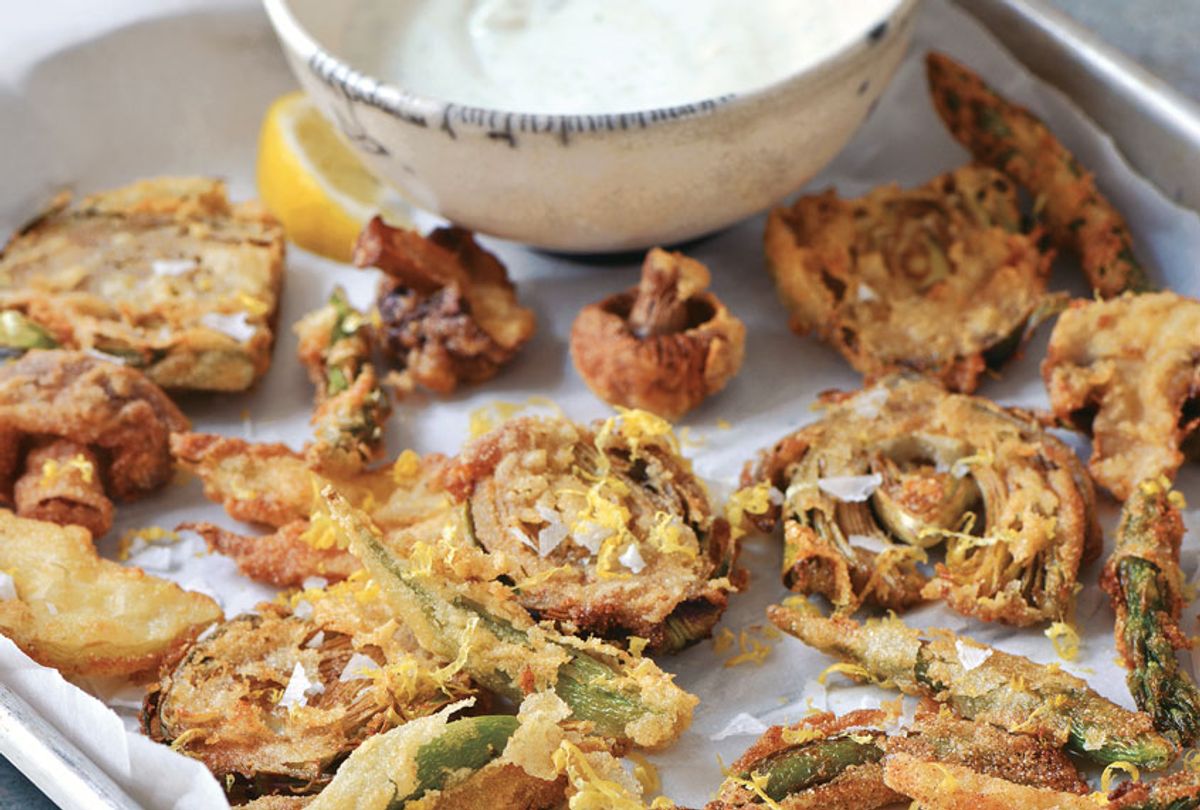Spring Fritto Misto
Serves 6
This bronzed and crispy “fried mix” of vegetables is out of this world. You can come up with a seasonal combination of vegetables that will be fun to eat this way at any time of year. But spring offers my favorite options: fennel, asparagus, sugar snap peas, and cremini mushrooms. (Baby artichoke hearts and paper-thin slices of lemon are awesome additions, too.) The process of dipping and frying the veggies can be a little messy, but I am telling you: The results are one hundred percent worth it.
The fritto misto is best served right away, while hot and crunchy, although I have also enjoyed it at room temperature. The tarragon dipping sauce is an extra (and easy-to-make) treat—and one that benefits from being made at least a half hour ahead—but if you’d rather skip it, a squeeze of lemon
will do just fine.
3/4 cup all-purpose flour
3/4 cup finely milled semolina flour (see Note, page 160)
2 teaspoons baking powder
1/4 teaspoon fine sea salt
1 cup buttermilk
Canola oil, for frying
6 to 8 asparagus spears, woody ends removed, cut into 2-inch lengths (avoid pencil-thin asparagus and jumbo asparagus)
1/2 small fennel bulb, halved, stem end trimmed, core intact to hold layers together, cut into ¼-inch-thick slices
4 ounces (about 1 1/2 cups) sugar snap peas, tips and strings removed
4 ounces cremini or button mushrooms, cleaned, stems removed (larger mushrooms halved)
Flaked sea salt, for finishing
1 lemon, cut into wedges, for serving
Tarragon Yogurt Sauce (page 179), for serving (optional)
- Whisk together the all-purpose flour, semolina flour, baking powder, and salt in a medium-size bowl. Place the mixture in a shallow rectangular dish or pan that will accommodate all of the vegetable shapes and sizes. Place the buttermilk in a separate but equally sized dish. Line a rimmed baking sheet with paper towels or parchment paper and set it next to the stove.
- Pour enough canola oil in a large saucepan or deep sauté pan to fill the pan about one-third full. Heat the oil over medium-high heat until it shimmers: Test its readiness by dropping in one vegetable piece. It should immediately sizzle and steadily simmer around the edges. Alternatively, for a more accurate gauge, attach an instant-read thermometer to the pan; the oil is ready when the temperature registers between 365° and 370°F.
- Working in batches, dip the vegetable pieces in the buttermilk, allowing any excess to drip off, then dredge them in the flour mixture. Once coated, lift the vegetable pieces, gently shake off any excess flour, and carefully lower them into the hot oil. Do not overcrowd the pan. Fry the vegetables, using tongs to turn them gently, until they are golden brown all over, 1 to 3 minutes. Remove the vegetables with a spider or slotted spoon and transfer them to the prepared baking sheet. Sprinkle the finished vegetables lightly with flaked sea salt. Repeat until all the vegetables are cooked, adjusting the heat as needed to crisp the vegetables without burning them.
- Arrange the finished fritto misto on a platter and serve immediately with lemon wedges, and with the yogurt sauce alongside if you wish.
Note: Semolina flour is ground durum wheat and is less fine than all-purpose wheat flours, although fine and coarse textures are available (I like Bob’s Red Mill Semolina Pasta Flour, which is finely milled). It is high in gluten, and is commonly used for making pasta and bread.
In summertime, make fritto misto with green beans, sliced onions, squash blossoms, and zucchini cut into 1/4-inch rounds. In the fall and winter, use bite-size broccoli and cauliflower florets, 2-inch pieces of broccoli rabe, 2-inch pieces of boiled cardoons, and thin sweet potato rounds.
Excerpted from "The Vegetable Butcher," by Cara Mangini (Workman Publishing). Copyright © 2018.



Shares